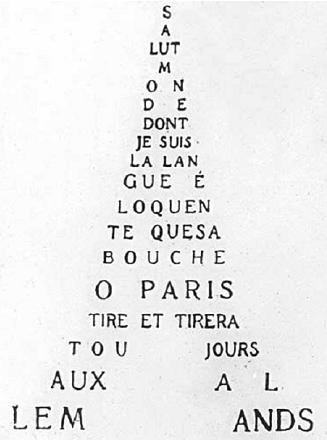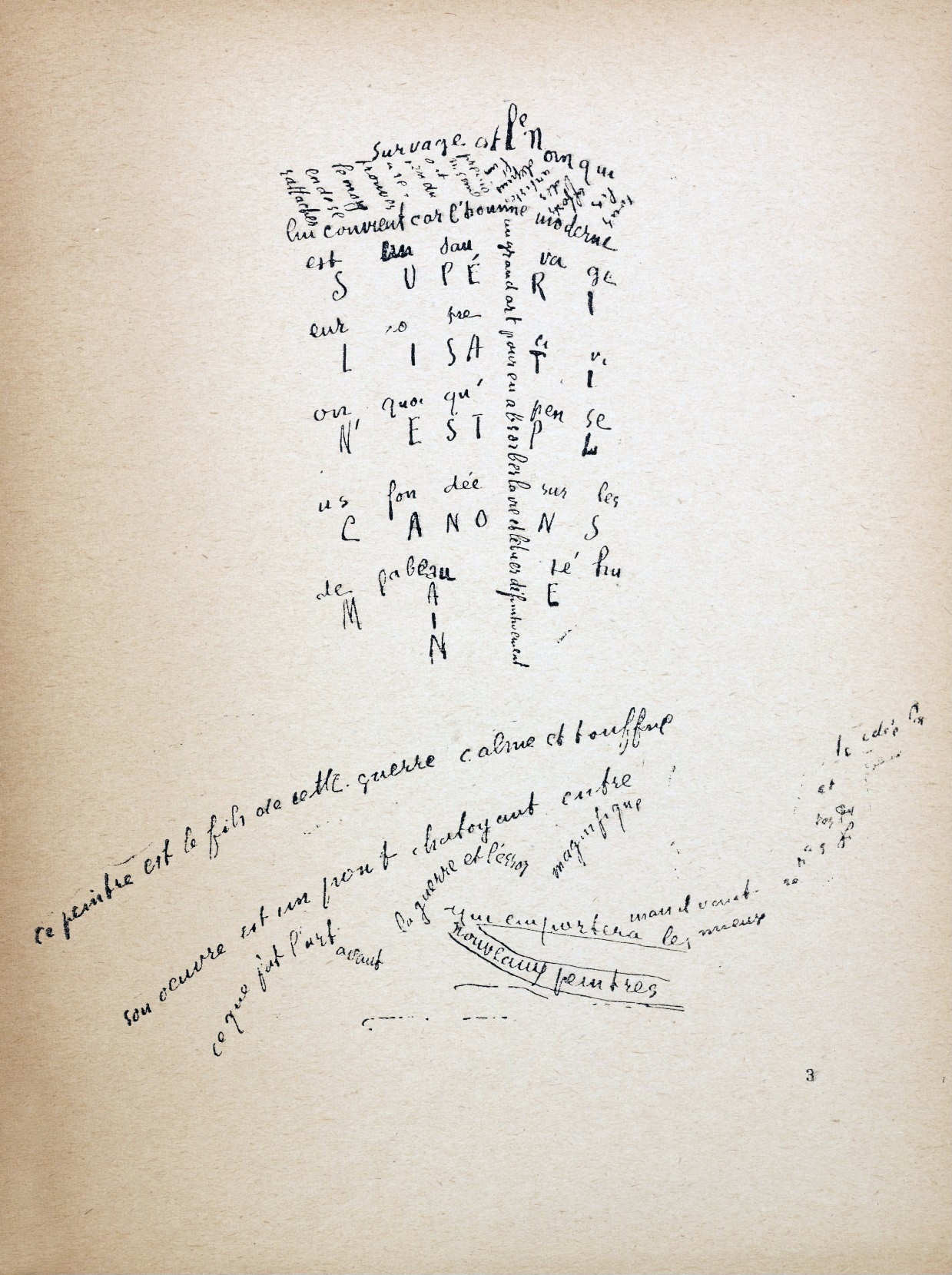Calligrammes on:
[Wikipedia]
[Google]
[Amazon]

 ''Calligrammes: Poems of Peace and War 1913-1916'', is a collection of
''Calligrammes: Poems of Peace and War 1913-1916'', is a collection of
File:Guillaume Apollinaire - Calligramme - Cheval.png
File:Guillaume Apollinaire - Calligramme - La Colombe poignardée et le Jet d’eau.png
File:Guillaume Apollinaire - Calligramme - Cœur, couronne et miroir.png
File:Guillaume Apollinaire - Calligramme - L'oiseau et le bouquet.png
File:Guillaume Apollinaire - Calligramme - La Mandoline, l’œillet et le bambou.png
File:Guillaume Apollinaire Voyage.jpg
File:Guillaume Apollinaire - Calligramme - Venu de Dieuze.png
File:Ilpleut.png
''Calligrammes; poèmes de la paix et da la guerre, 1913-1916''
digitized original at the
''Calligrammes, for piano trio''
French poems 1918 books Works by Guillaume Apollinaire {{poetry-collection-stub
 ''Calligrammes: Poems of Peace and War 1913-1916'', is a collection of
''Calligrammes: Poems of Peace and War 1913-1916'', is a collection of poem
Poetry (derived from the Greek ''poiesis'', "making"), also called verse, is a form of literature that uses aesthetic and often rhythmic qualities of language − such as phonaesthetics, sound symbolism, and metre − to evoke meanings in ...
s by Guillaume Apollinaire
Guillaume Apollinaire) of the Wąż coat of arms. (; 26 August 1880 – 9 November 1918) was a French poet, playwright, short story writer, novelist, and art critic of Polish descent.
Apollinaire is considered one of the foremost poets of the ...
which was first published in 1918 (see 1918 in poetry
Nationality words link to articles with information on the nation's poetry or literature (for instance, Irish or France).
Events
* January 23 — English poet Robert Graves marries the painter Nancy Nicholson in London. Wedding guests includ ...
). ''Calligrammes'' is noted for how the typeface and spatial arrangement of the words on a page plays just as much of a role in the meaning of each poem as the words themselves – a form called a calligram
A calligram is text arranged in such a way that it forms a thematically related image. It can be a poem, a phrase, a portion of scripture, or a single word; the visual arrangement can rely on certain use of the typeface, calligraphy or handwrit ...
. In this sense, the collection can be seen as either concrete poetry
Concrete poetry is an arrangement of linguistic elements in which the typographical effect is more important in conveying meaning than verbal significance. It is sometimes referred to as visual poetry, a term that has now developed a distinct mea ...
or visual poetry
Literary theorists have identified visual poetry as a development of concrete poetry but with the characteristics of intermedia in which non-representational language and visual elements predominate.
Differentiation from concrete poetry
As the l ...
. Apollinaire described his work as follows:
The ''Calligrammes'' are an idealisation offree verse Free verse is an open form of poetry, which in its modern form arose through the French ''vers libre'' form. It does not use consistent meter patterns, rhyme, or any musical pattern. It thus tends to follow the rhythm of natural speech. Definit ...poetry and typographical precision in an era whentypography Typography is the art and technique of arranging type to make written language legible, readable and appealing when displayed. The arrangement of type involves selecting typefaces, point sizes, line lengths, line-spacing ( leading), and ...is reaching a brilliant end to its career, at the dawn of the new means of reproduction that are thecinema Cinema may refer to: Film * Cinematography, the art of motion-picture photography * Film or movie, a series of still images that create the illusion of a moving image ** Film industry, the technological and commercial institutions of filmmaking ...and thephonograph A phonograph, in its later forms also called a gramophone (as a trademark since 1887, as a generic name in the UK since 1910) or since the 1940s called a record player, or more recently a turntable, is a device for the mechanical and analogu .... (Guillaume Apollinaire Guillaume Apollinaire) of the Wąż coat of arms. (; 26 August 1880 – 9 November 1918) was a French poet, playwright, short story writer, novelist, and art critic of Polish descent. Apollinaire is considered one of the foremost poets of the ..., in a letter toAndré Billy André Billy (13 December 1882 – 11 April 1971) was a French writer. He was born in Saint-Quentin, Aisne. After completing secondary studies at the Collège de la Providence in Amiens, he studied under the Jesuits at Saint-Dizier. He began ...)Apollinaire, Guillaume, quoted in the preface byMichel Butor Michel Butor (; 14 September 1926 – 24 August 2016) was a French poet, novelist, teacher, essayist, art critic and translator. Life and work Michel Marie François Butor was born in Mons-en-Barœul, a suburb of Lille, the third of seven childre .... ''Calligrammes'', p. 7 (Éditions Gallimard, preface copyright 1966).
Notes
References
*Apollinaire, Guillaume. ''Calligrammes''. Preface byMichel Butor
Michel Butor (; 14 September 1926 – 24 August 2016) was a French poet, novelist, teacher, essayist, art critic and translator.
Life and work
Michel Marie François Butor was born in Mons-en-Barœul, a suburb of Lille, the third of seven childre ...
. (Éditions Gallimard, 1995)
External links
''Calligrammes; poèmes de la paix et da la guerre, 1913-1916''
digitized original at the
Internet Archive
The Internet Archive is an American digital library with the stated mission of "universal access to all knowledge". It provides free public access to collections of digitized materials, including websites, software applications/games, music, ...
* ''Calligrammes'' (full text)
''Calligrammes, for piano trio''
French poems 1918 books Works by Guillaume Apollinaire {{poetry-collection-stub